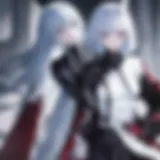In-Depth Look at Demon Slayer Volume 1 on Amazon
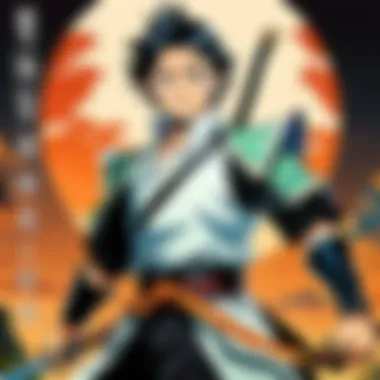

Intro
Demon Slayer has taken the anime and manga world by storm, garnering fans of all ages with its unique storyline and rich character arcs. This article hones in on Volume 1 of the manga, available on Amazon, to dissect what makes it a compelling addition to the modern manga landscape. From its well-crafted characters to the intricate themes woven through its pages, we will explore the key aspects that have allowed this series to resonate with audiences around the globe.
Anime Series Overview
Brief Synopsis of the Anime Series
Riding the wave of the Shonen genre, Demon Slayer follows the journey of Tanjiro Kamado, a kind-hearted boy who becomes a demon slayer after his family is brutally slaughtered. His younger sister, Nezuko, is turned into a demon but retains her sense of humanity. Throughout the series, Tanjiro battles various demons, seeking a cure for Nezuko and vengeance for his family. The story is rich with themes of resilience, sacrifice, and the struggle between good and evil.
Prelims to Main Characters
- Tanjiro Kamado: He embodies kindness and determination, always seeking to understand his enemies. His growth from a simple boy to a skilled demon slayer is captivating.
- Nezuko Kamado: As Tanjiro's younger sister, her transformation into a demon poses challenges and opportunities for redemption. Her fierce loyalty and protective instincts make her a formidable ally.
- Zenitsu Agatsuma: Initially presented as cowardly, his character evolves significantly as the series unfolds. Zenitsu's evolution showcases the varying layers of bravery.
- Inosuke Hashibira: Known for his boar mask and brash demeanor, Inosuke adds a rough edge to the group dynamic and serves as a contrast to Tanjiro's calm approach.
Discussion on Animation Style, Soundtrack, and Notable Episodes
While this section centers on the manga, it’s impossible to ignore how the animation has boosted its popularity. The vivid animation style and powerful soundtrack amplify the emotional weight of each scene. Notably, episodes featuring Tanjiro's first encounters with demons are particularly striking, filled with breathtaking visuals and intense music.
Character Analysis
Detailed Breakdown of Main Characters
Each character in Demon Slayer serves a purpose, from Tanjiro's empathy to Inosuke's instinctive aggression. The depth of their personalities is reflected in their actions and decision-making. For instance, Tanjiro’s journey is not purely about slaying demons; it also involves understanding them and uncovering the painful history behind their transformation.
Character Relationships and Dynamics
The relationship between Tanjiro and Nezuko forms the emotional core of the series. Their bond, forged in trauma yet filled with love and support, resonates strongly with the audience. The camaraderie among Tanjiro, Zenitsu, and Inosuke makes for an entertaining dynamic, often highlighting contrasting personalities and their growth throughout the journey.
Impact of Characters on The Overall Storyline
The characters don’t just drive the plot; they also spark numerous fan theories. For example, the unexplained interaction between Nezuko and certain demons raises tantalizing questions, inviting speculation about demon lore.
Genre Spotlight
Preamble to the Specific Genre of the Anime Series
Demon Slayer fits snugly into the Shonen category, which often features young male protagonists facing powerful adversaries. It shares similarities with series like Naruto and My Hero Academia, but stands out due to its strong emotional narrative.
History and Evolution of the Genre
The Shonen genre has evolved significantly, especially with the rise of digital platforms. Its roots can be traced back to the early days of manga and anime, often emphasizing adventure, friendship, and rivalry. Today, it increasingly focuses on emotional depth alongside traditional themes of battles and quests.
Notable Series within the Genre
While numerous series populate this genre, few manage to blend deep psychological themes with action as effectively as Demon Slayer. Other notable titles include Attack on Titan and One Piece. Each series contributes its own flavor to Shonen, yet Demon Slayer manages to carve out a distinctive niche for itself.
Behind-the-Scenes Insights
Exploration of the Production Process
Demon Slayer went through a meticulous production process, from the initial concept to the screen adaptation. Developed by Ufotable, the animation studio is known for its focus on quality, promising a visually stunning experience.
Challenges Faced During Production
Every anime production faces hurdles. For Demon Slayer, meeting the high expectations of fans while adhering to the manga’s intricate storylines posed significant challenges. However, the creators’ dedication to authenticity paid off, resulting in smooth storytelling and captivating animation.
Success Factors of the Anime Series
The key to its success lies in a combination of factors. From top-tier animation to character-driven plots, these elements resonate with viewers, ensuring that Demon Slayer maintains a strong foothold in popular culture.
"Demon Slayer's unique blend of action, depth, and artistry has made it more than just a series; it’s a phenomenon."
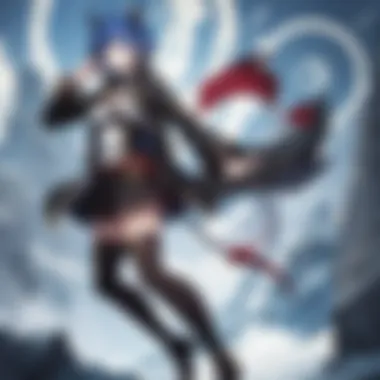

In wrapping up, the exploration of Demon Slayer Volume 1 on Amazon showcases not just its critical and commercial successes, but also how it represents a significant chapter in modern anime and manga culture.
Overview of Demon Slayer Volume
The first volume of Demon Slayer: Kimetsu no Yaiba serves as an essential introduction to the series, laying down the fundamental elements that make it captivating for readers. Understanding this volume is crucial, as it sets the tone for the entire narrative, presenting pivotal themes and character dynamics that resonate throughout the series. It’s not just a prelude; it’s a lens through which the audience can appreciate the broader arcs that follow.
Demon Slayer’s success can largely be attributed to how effectively it merges compelling storytelling with rich world-building. Readers of manga often look for depth in both character development and the surrounding universe, and this volume does not disappoint. By diving into the intricate details of the plot and the lives of the characters introduced, one begins to unravel a tapestry of adventure, friendship, and the eternal struggle between light and dark.
Plot Summary
The story kicks off with Tanjiro Kamado, a young boy who lives a simple and humble life in the mountains with his family. One fateful day, his life spins off its axis when he returns home after selling charcoal to find his family brutally slaughtered by demons. The only survivor is his younger sister, Nezuko, who has been turned into one of these malevolent beings.
Tanjiro’s journey becomes a quest for vengeance and redemption as he vows to avenge his family and find a way to turn Nezuko back into a human. This initial conflict represents not just a fight against demons, but also a battle against the despair and sorrow that can accompany loss. The urgency of his mission drives the narrative forward, capturing the attention of readers right from the first few pages.
Main Characters Introduced
This volume reintroduces us quite notably to Tanjiro, whose resilience and compassion set him apart from other protagonists in similar genres. His character embodies a unique blend of determination and empathy, making him a figure readers can root for. Alongside him is Nezuko, whose transformation challenges the traditional demon template, offering a glimpse into the complexity of their relationship as siblings.
Moreover, readers are also introduced to several significant characters along Tanjiro’s path. For example, Giyu Tomioka, a demon slayer from the Water Hashira, plays a crucial role in guiding Tanjiro. His calm demeanor contrasts sharply with Tanjiro's fiery spirit, and their interactions help bridge the gap between novice and experienced demon slayers.
Setting and World-Building
The setting unfolds in a historical Japan, echoing with the ambiance of the Taisho era. The visuals and environments crafted by Koyoharu Gotouge expertly evoke a sense of realism, immersing the reader in a world filled with both beauty and horror. Mountains, forests, and traditional villages form the backdrop against the grisly reality of demons lurking in the shadows, creating a stark juxtaposition.
World-building does not merely exist as a backdrop; it plays an active role in the characters' development and the narrative's progression. Each location, from Tanjiro's home to the mysterious landscapes where battles unfold, carries a narrative weight, embodying the themes of loss and the quest for hope amidst darkness.
Understanding these elements allows readers to grasp the full impact of what Demon Slayer Volume 1 brings to the table. This volume is more than just an introduction; it’s the cornerstone of a beloved franchise that challenges readers to contemplate deep emotional issues while providing thrilling adventure.
Demon Slayer's Place in the Anime Landscape
Demon Slayer, or Kimetsu no Yaiba, has carved out a distinguished place for itself within the realm of anime. This piece serves as a window into how this series has developed not just its narrative but its cultural impact as well. It’s not merely a story of demons and slayers; it encapsulates themes and emotions that resonate widely with audiences. In examining its influence, we look deeper than just the visuals and the action-packed sequences; we delve into the ethos that drives its popularity.
Cultural Significance
One can't talk about Demon Slayer without addressing its cultural significance. The series has successfully spun a web of traditional Japanese folklore and contemporary issues, interlinking the experiences of its characters with themes universal to human experience. At its core, the saga highlights the familial bonds, love, and loss—elements that transcend borders. For instance, the protagonist Tanjiro operates from a profound moral compass, tirelessly striving to return his sister Nezuko to her human form while avenging his family's brutal murder. Such a plight mirrors real-life themes of sacrifice and duty.
In Japan, the release of the anime and the manga had a significant impact beyond just entertainment. It sparked conversations about mental health, resilience, and emotional strength in the wake of adversity. This has led to a coalition of fans rallying around shared experiences, often taking to platforms like Reddit to share personal stories tied to the series’ themes. These interactions underline how Demon Slayer has become a cultural touchstone for many—a catalyst for communal dialogue.
Moreover, the series has given rise to various merchandise, artworks, and even themed cafés, reflecting how deeply integrated it has become in consumer culture. As viewers purchase items or engage with related content, they contribute to a larger ecosystem that supports both the franchise and their personal connection to it.
Comparative Analysis with Other Titles
When placed side by side with other series in the shonen genre, such as My Hero Academia or Attack on Titan, Demon Slayer emerges with distinct attributes. While many series rely heavily on power dynamics and intense battles, Demon Slayer sweetens its narrative with emotional depth and stunning visuals.
- Character Development: For instance, unlike the relentless character upgrades seen in many shonen titles, Tanjiro's journey emphasizes self-improvement balanced with the burdens he carries. This duality adds layers to his character rarely explored in conventional shonen tropes.
- Artistry: As for the visuals, the breathtaking animation produced by Ufotable has set a new benchmark. The seamless blend of 2D and 3D techniques is a feast for the eyes. This attention to detail catapults it beyond mere action sequences, giving weight to the story being told.
- Thematic Richness: While Attack on Titan focuses on survival and existential crises, Demon Slayer offers a softer lens, examining the bonds between characters, the significance of heritage, and the role of nature and tranquility amid chaos.
The promise of Demon Slayer also lies in its accessibility. It serves as an entry point for newcomers to the world of anime, just as Naruto did a decade prior. Its balanced approach to storytelling appeals to a broader audience, forging connections among those who may not typically partake in anime culture.
Availability on Amazon
When it comes to obtaining Demon Slayer Volume 1, Amazon stands out as a key player in the manga distribution landscape. This platform brings a mix of convenience, vast selection, and accessibility that appeals to anime and manga fans alike. Given the rise of digital shopping, the ease with which readers can acquire such beloved titles cannot be understated. Here are a few aspects to consider:
- Convenience: Ordering through Amazon means that fans can simply browse, select, and receive their volumes right at their doorstep without the hassle of visiting multiple stores.
- Widespread Availability: The chances of finding a physical copy, especially in regions where specialized manga stores might be sparse, are greatly increased. Many readers also appreciate being able to purchase both physical and digital copies.
- Customer Reviews: One of the enchanting aspects about shopping on Amazon is the sheer volume of user feedback, which provides insights on not just the story but also the physical edition of the book, such as quality of print and binding.
Price Analysis
A look at price variations reveals a lot about the market dynamics for Demon Slayer Volume 1 on Amazon. The price point can fluctuate based on several factors: condition (new vs. used), seller reputation, and whether there are any promotions or discounts at play. While new copies typically hover around the average retail price—often between $9.99 and $12.99—used editions might be found at a lower price, appealing to budget-conscious readers. Furthermore, Prime members might enjoy additional savings through exclusive deals and free shipping options.
Formats Offered
Readers on Amazon can choose from a myriad of formats for Demon Slayer Volume 1:
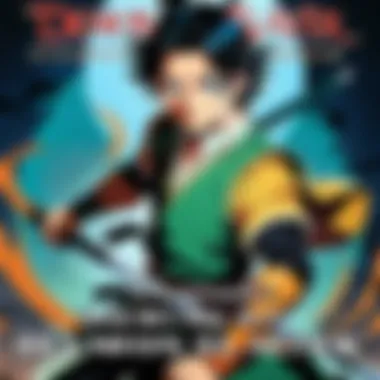

- Paperback: The classic format that many manga enthusiasts prefer for its tactile experience. It’s sturdy, portable, and easy to display.
- Kindle Edition: Ideal for readers who embrace digital formats. The Kindle version provides a convenient way to read on the go, though it lacks the charm of printed artwork.
- Collector's Editions: Occasionally, Amazon features special editions that include extras such as artwork or behind-the-scenes content, targeting dedicated fans.
These options allow readers to select the version that fits their lifestyle and reading habits.
Shipping Options and Availability
Amazon’s renowned shipping capabilities amplify its attractiveness for fans pursuing Demon Slayer Volume 1. Generally, buyers can expect:
- Fast Shipping: Depending on the sellers, options might include two-day shipping for Prime members or even same-day delivery in some areas.
- International Delivery Options: For enthusiasts living outside the U.S., the platform often features sellers who offer international shipping, making it easier to get copies of popular series.
- Stock Availability: Notably, Amazon's vast network means it typically has stock on hand, reducing the risk of long wait times. Popularity does drive periods of out-of-stock situations, but Amazon's efficient fulfillment and third-party sellers mitigate this issue.
"The available formats and swift shipping options make buying Demon Slayer Volume 1 an almost effortless endeavor for devoted fans."
In sum, the topic of availability on Amazon reflects the modern consumer's needs for accessibility and efficiency, and it's an essential thread woven into the ultimate experience of engaging with Demon Slayer Volume 1.
User Reviews and Critique
User reviews and critiques play a vital role in understanding how a work like Demon Slayer Volume 1 resonates with its audience. Reviews from readers can provide different perspectives on narrative depth, artistic elements, and character dynamics. When exploring this volume on Amazon, examining user feedback helps determine not only the book's quality but also the elements that contribute to its popularity and weaknesses that may warrant consideration.
In the crowded world of anime and manga, where every title vies for attention, the voice of the audience helps filter the noise. Reviews often encapsulate genuine feelings that formal critiques may overlook, shedding light on personal connections readers forge with the material. Ultimately, the collection of opinions from users showcases the broader impact the series has had on its audience.
Positive Feedback
Readers have expressed a significant affinity for the compelling storytelling and rich emotional undertones found in Demon Slayer Volume 1. Many have highlighted key aspects such as:
- Strong Character Development: Tanjiro Kamado’s evolution as a protagonist, overcoming personal loss while nurturing a sense of empathy, resonates deeply with fans.
- Stunning Art Style: The visuals, from gripping fight scenes to serene moments, are often lauded as breathtaking and effectively amplify the story’s nuances.
- Engaging Plot Progression: The pacing of the narrative keeps readers on their toes, balancing intense action with meaningful character interactions.
"The way Tanjiro deals with grief is something I have never seen depicted so beautifully in manga. It made me think, and I kept turning the pages!"
- Relatable Themes: Themes of struggle, perseverance, and the bonds of family strike a chord with a wide range of readers, making it a particularly poignant read for those experiencing similar challenges.
Common Criticisms
While there is a general wave of positivity surrounding the volume, it is not without its detractors. Some common criticisms include:
- Predictable Tropes: Certain readers feel that the storyline relies on familiar tropes typical of the shonen genre, leaving less room for surprise.
- Pacing Issues: A few mentions discuss how certain sections could feel rushed or overly drawn out, impacting the overall reading experience.
- Character Familiarity: Some users argue that while the main characters are fleshed out, secondary characters lack depth, leading to a less robust emotional canvas.
Critical Reception Overview
The critical reception of Demon Slayer Volume 1 has been remarkably positive across various platforms. Critics often commend the work for several reasons, including:
- Innovative Blend of Tradition and Modernity: The series merges traditional Japanese culture with contemporary storytelling techniques, allowing it to appeal to a diverse audience.
- Overall Quality and Craftsmanship: Notables in the manga industry have acknowledged the meticulous detail in both artwork and storytelling.
- Impactful Emotional Themes: Many reviewers appreciate the emotional thematic content, which underscores issues such as family bonds and personal sacrifice.
On platforms like Amazon, where feedback is plentiful, the contrasting views add depth to the understanding of the volume's reception. Readers from various backgrounds contribute to an ongoing dialogue about the impact that Demon Slayer Volume 1 has made since its release.
Illustrative Elements and Art Style
In the world of manga and anime, the artistry is not merely aesthetic; it resonates deeply with the narrative, conveying emotions and themes that words alone often can't. Demon Slayer Volume 1 showcases a brilliant interplay of illustrative elements and art style that elevates its storytelling. From the chaotic battles to the serene landscapes, the artistic choices made in this volume define the reader's experience.
Artistic Techniques Employed
The artistic techniques in Demon Slayer are a feast for the eyes, blending traditional and modern styles. The creators use techniques like line work, color gradients, and dynamic paneling to create immersive visuals. Here’s a glimpse of how these techniques operate:
- Use of Contrast: Dark shades often represent demonic presence, while light colors are reserved for human characters, effectively illustrating the stark differences between good and evil.
- Cinematic Angles: The angles of the illustrations give a sense of movement and urgency, especially during action sequences. You feel the tension and adrenaline of a fight, which draws you in further.
- Expressive Facial Expressions: The characters are beautifully illustrated with wide-ranging expressions to convey their feelings. Whether it's fear, hope, or anger, these expressions add depth and relatability.
These techniques work hand-in-hand to not only depict the fantasy world but also emphasize the stakes involved.
Character Design Analysis
Character design in Demon Slayer is another noteworthy aspect of its art style. Each character is meticulously crafted, illustrating their unique backstory and role in the narrative. Here are a few important points about character design:
- Distinctive Features: Every character has unique hairstyles, clothing, and accessories that reflect their personality. For instance, Tanjiro’s scar and checkered haori convey his warrior spirit and humble origins.
- Symbolism in Design: The colors and forms used in character designs are often symbolic. For example, Nezuko’s bamboo muzzle not only serves a functional purpose but visually symbolizes her struggle between human and demon.
- Cohesion with Theme: The designs align closely with the overarching themes of family ties and resilience. The characters’ visual stories intertwine perfectly with the plot’s emotional beats.
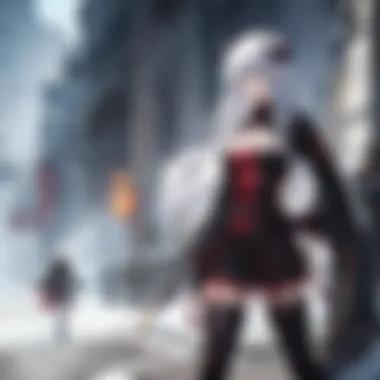

As such, the artistic elements used in Demon Slayer Volume 1 resonate deeply with readers, making the visuals as compelling as the storyline itself.
"Art speaks where words are unable to explain." This sentiment captures how the illustrations in Demon Slayer do more than complement the plot—they become a vital character in their own right.
The art style and illustrative elements thus not only serve as decoration but act as a conduit for thematic exploration, engaging the audience beyond the written word.
Thematic Elements of Volume
The thematic elements in Demon Slayer Volume 1 play a crucial role in not just setting the narrative's foundation but also in shaping the emotional landscape of its characters. Themes such as family ties, sacrifice, and the perennial struggle of good against evil aren't just mere story details; they resonate deeply with the audience, making the experience far more engaging. These elements weave together to create a rich tapestry that both anime and manga lovers can appreciate.
Family and Sacrifice
In Demon Slayer Volume 1, the theme of family is strikingly evident, especially through the protagonist, Tanjiro Kamado. His entire journey kicks off with an awful tragedy that takes his family away, leaving him with only his sister, Nezuko, who becomes a demon. This relationship is not just a plot device; it reflects the essence of familial bonds that many of us value.
Tanjiro's love for Nezuko transcends the horror of her transformation. He does not see her as a monster; rather, he views her as family, demonstrating the profound strength of familial loyalty. This is not merely about blood relations, but it resonates with the concept of sacrifice. Tanjiro makes sacrifices, whether it be his physical well-being or emotional stability, for Nezuko's sake. This theme encourages readers to reflect on their relationships and consider how far they would go for loved ones.
A notable moment that encapsulates this theme occurs when Tanjiro vows to find a cure for Nezuko’s condition and protect her at all costs. This pivotal determination paints a vivid picture of true familial love and sacrifice. Such moments strike a chord, often reminding us of our own commitments to those we cherish.
Good versus Evil Motif
The age-old struggle of good versus evil unfolds throughout Volume 1 and serves as a crucial lens through which the narrative is examined. The Demon Slayer universe presents a clear delineation between the protagonists, like Tanjiro, and the antagonists, the demons. What elevates this theme, however, is how it explores the complexity of these sides.
While the demons represent evil, many of them were once human beings who succumbed to their darker instincts, creating a layered interpretation of morality. This complicates the black-and-white worldview; can creatures with tragic backstories truly be regarded as purely evil? This thought bubbles under the surface and adds richness to the narrative.
Tanjiro embodies the moral challenge of confronting evil while simultaneously seeking to understand its origins. His growth reflects the internal struggle to maintain one’s own morality while battling against the darkness, both literal and symbolic, that threatens his loved ones.
“In every corner, good battles evil, but the lines of right and wrong often blur, pushing us to question our own beliefs.”
Therefore, the good versus evil motif is not merely a backdrop for action sequences; it serves to challenge the reader to reflect on their own values and beliefs in the context of a changing world.
Indeed, the thematic depth in Volume 1 of Demon Slayer contributes significantly to its resonance with fans. It encourages introspection regarding the bonds we forge and the moral landscapes we navigate throughout our lives.
Impact on the Anime Community
The release of Demon Slayer Volume 1 has sent ripples throughout the anime community that extend far beyond its pages. This series has ignited conversations among fans, critics, and content creators alike. It's not just another entry into the ever-expanding universe of anime and manga; it has reshaped expectations in storytelling, art, and character development. The significance of this impact reverberates through various facets of the community, including the influence it has on upcoming titles and the engagement it fosters among fans.
Influence on Future Titles
One of the most palpable effects of Demon Slayer on future anime and manga titles lies in its approach to character arcs and narrative depth. With Tanjiro Kamado serving as a relatable protagonist, many creators feel a drive to develop their leads with similar emotional resonance. This series places immense emphasis on family bonds and personal sacrifice, compelling future creators to explore these themes more thoroughly. Here are a few points to consider:
- Character Complexity: The success of Demon Slayer has shown that audiences crave depth. Future series are likely to offer more intricate character backstories and motivations.
- Narrative Innovation: Content creators are inspired to experiment with the blend of action and emotion, mirroring the blend found in Demon Slayer.
- Focus on World-Building: The rich lore surrounding demon slayers has set a benchmark for detailed world-building. New series are expected to offer similar layers of historical and mythological context, establishing a world where viewers can easily immerse themselves.
Fan Engagement through Social Media
Demon Slayer has not only influenced the fabric of storytelling but also reshaped how fans interact within the community. Through social media platforms, enthusiasm for the series burgeons into content stretches that purvey beyond just discussions. Fans are engaged through various channels, creating a living dialogue that keeps the series alive long after they finish reading.
- Sharing Art and Cosplay: Fans often share their own artwork and cosplay interpretations of characters, which contribute to a visual dialogue that fosters community interaction.
- Discussion Spaces: Subreddits and Facebook groups dedicated to Demon Slayer serve as hubs for theories, debates, and fanfiction. This kind of engagement leads to a deeper appreciation of the work, encouraging more fans to explore the subtle nuances that enrich the narrative.
- Reactions and Reviews: Platforms like YouTube have become a space for fans analyzing episodes and chapters, highlighting their personal connections to the characters and storylines. Such reviews often lead to significant viewership and discussions around the latest content from the franchise.
Through social media, Demon Slayer acts as a facilitator of community, where shared interests bridge gaps between diverse fans.
The End
The conclusion serves as a vital part of our journey through Demon Slayer Volume 1 and its footprint within both the broader anime landscape and on Amazon. This section weaves together the many threads we've examined throughout the article, highlighting the key elements that make this manga a significant cultural piece today. From the initial plot dynamics to the rich thematic explorations, we can see that it has carved a niche for itself among the multitude of manga series available.
In times when content consumption shifts rapidly, understanding the relevance of each element discussed herein is critical.
Summary of Key Points
- Character Arcs: We covered the essential character introductions and their journeys, particularly that of Tanjiro Kamado, illustrating how personal struggles resonate with readers.
- Themes: The motifs of family and sacrifice were assessed, emphasizing how they elevate the narrative beyond mere entertainment to something that speaks to deeper human experiences.
- Cultural Impact: We also discussed the significance of Demon Slayer within the anime community, noting its influence on current titles and fan engagement, particularly through social media platforms.
- Amazon's Role: The availability of Volume 1 on Amazon provides a crucial lens into how modern consumers access and enjoy this art form. E-commerce shapes our media landscape, affecting what titles gain momentum and how audiences interact with them.
Final Thoughts on Volume
Reflecting on Volume 1, it stands out not merely as a manga but as a cultural artifact that captures the struggles and aspirations of its characters in a beautifully drawn world. Its ability to blend thrilling action with poignant emotional moments makes it a read worth diving into.
As the story unfolds through subsequent volumes, the foundation laid in this first installment serves as a stepping stone for greater themes and complex narratives.
By engaging with and discussing Demon Slayer Volume 1, readers not only discover a compelling story but also participate in a larger dialogue about culture, identity, and the struggles that humans face. This is crucial for anime and manga lovers who wish to navigate the increasingly complex landscape of modern narratives. By investing themselves in both the medium and its community, they are attuning to voices that echo their own experiences and dreams.
In closing, readers are encouraged to explore not just the manga, but also its community discussions, reviews, and fan art. This deep engagement creates a more enriching experience, ultimately contributing to the continuing evolution of manga as a beloved art form.
